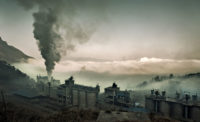BP is fighting battles on multiple fronts.
It’s battling the oil gushing out of the well after the April 20 explosion aboard the Deepwater Horizon drill rig in the Gulf of Mexico.
It’s fighting what it claims is misinformation about the oil spill’s extent and environmental impacts.
And in the latest skirmish, BP is defending itself against claims that its engineering documentation may have led to the blast that killed 11 workers aboard the rig.
The UK-based oil company appears to be making the most progress battling the spill. It contends that as of May 18, its crews were capturing as much as 40% of all oil coming out of the Macondo exploration well, with use of an insertion tool (see main story). BP also claims that within a week after that date, it will attempt to completely stop the oil flow using a “top kill” procedure.
In this effort, the company will attempt to out race the oil coming out of the well by forcing down heavy drilling mud at 40 barrels per minute. If this “top kill” procedure fails to work completely, and oil continues to flow through the blowout preventer, BP will attempt a maneuver officials call a “junk shot.”
BP Senior Vice President Kent Wells says the junk shot has been tested for about 10 days onshore. The junk shot and top kill would be temporary fixes to stop the flow of oil. Wells says that the well will be only permanently capped through one of two relief wells now being drilled that are not set for completion until August.
BP, along with the U.S. National Oceanic and Atmospheric Administration (NOAA), was also busy contesting reports that oceanographers have discovered large and deep plumes of oil in the Gulf that are not visible from the surface.
NOAA claims the plumes have been mischaracterized, noting that they are not deep columns of thick oil, but fine drops of oil suspended in the water. The agency says droplets are so fine that they do not obscure visibility.
BP is also fighting claims over its engineering practices. A former contracted project supervisor, Ken Abbott, alleges that the problems aboard the Deepwater Horizon may stem from systemic problems with engineering documentation at BP that he discovered while creating a database of engineering documents for Atlantis, another BP platform located about 150 miles south of New Orleans.
Abbott, along with the Washington D.C., consumer rights group, Food and Water Watch, filed suit against BP and the federal Minerals Management Service (MMS), a unit of the Interior Dept., asking the government to shut down production the Atlantis platform, claiming that the lack of approved “as-built” engineering documents for the structure could result in a catastrophe far greater than that of the Deepwater Horizon. Atlantis produces oil from about 20 fields in the Gulf of Mexico.
MMS did not immediately return phone calls seeking comment, but BP issued a statement saying it “had thoroughly investigated these claims when they were first made by a former contract worker in 2009 and found them to be without substance.”
Abbott claims that while performing work for BP, he discovered in 2008 that fewer than 10% of the 7,176 as-built documents for Atlantis had been approved. Only 50 of 7,176 drawings detailing its subsea component were approved for design, 459 approved for construction and only 274 as-built plans approved.
In his suit, he contends that 100% of the wellhead documents for the Atlantis failed to receive BP engineering approval. “Therefore, it is likely that not one wellhead record existed that accurately indentifies the exact specifications of the connectivity of the fittings, valves and controls,” the suit claims.
According to the suit, “engineering documents are critical to operations, as they reflect precisely the design of the component and system and can be likened to vital ‘blueprints’ for an incredibly complex structure involving millions of moving parts and systems.
Simply put, without properly maintained ‘as-built’ engineering documents, persons operating the BP Atlantis facility are flying blind, and have no way to assure the safety of offshore drilling operations and no way to assure that another calamitous oil spill, like the Deepwater Horizon spill, will not reoccur.”
The lawsuit adds that the Deepwater Horizon incident “is likely related to BP’s failure to abide by industry standard safety practices.”

